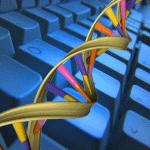Bioinformatics
|
15 november 2017 10:01:33 |
| Characterization of cysteine thiol modifications based on protein microenvironments and local secondary structures (Proteins: Structure, Function, and Bioinformatics) |
|
Tweet We have demonstrated earlier that protein microenvironments were conserved around disulphide-bridged cystine motifs with similar functions, irrespective of diversity in protein sequences (Bhatnagar et al., 2016; 84:1576-1589) . Here, cysteine thiol modifications were characterized based on protein microenvironments, secondary structures and specific protein functions. Protein microenvironment around an amino acid was defined as the summation of hydrophobic contributions from the surrounding protein fragments and the solvent molecules present within its first contact shell (Bandyopadhyay and Mehler, Proteins 2008; 72:646-659). Cysteine functions (modifications) were grouped into enzymatic and non-enzymatic classes. Modifications studied were - disulphide formation, thio-ether formation, metal-binding, nitrosylation, acylation, selenylation, glutathionylation, sulfenylation and ribosylation. 1079 enzymatic proteins were reported from high-resolution crystal structures. Protein microenvironments around cysteine thiol, derived from above crystal structures, were clustered into three groups - buried-hydrophobic, intermediate and exposed-hydrophilic clusters. Characterization of cysteine functions were statistically meaningful for four modifications (disulphide formation, thioether formation, sulfenylation and iron/zinc binding) those have sufficient amount of data in the current dataset. Results showed that protein microenvironment, secondary structure and protein functions were conserved for enzymatic cysteine functions, in contrast to the same function from non-enzymatic cysteines. Disulphide forming enzymatic cysteines were tightly packed within intermediate protein microenvironment cluster, have alpha-helical conformation and mostly belonged to CxxC motif of electron transport proteins. Disulphide forming non-enzymatic cysteines did not belong to conserved motif and have variable secondary structures. Similarly, enzymatic thioether forming cysteines have conserved microenvironment compared to non-enzymatic cystienes. Based on the compatibility between protein microenvironment and cysteine modifications, more efficient drug molecules could be designed against cysteine-related diseases. This article is protected by copyright. All rights reserved. |
| 159 viewsCategory: Biochemistry, Bioinformatics |
 Prediction of protein structure with the coarse-grained UNRES force field assisted by small X-ray scattering data and knowledge-based information (Proteins: Structure, Function, and Bioinformatics) Prediction of protein structure with the coarse-grained UNRES force field assisted by small X-ray scattering data and knowledge-based information (Proteins: Structure, Function, and Bioinformatics)Evaluation of the template-based modeling in CASP12 (Proteins: Structure, Function, and Bioinformatics) 
|
| blog comments powered by Disqus |
MyJournals.org
The latest issues of all your favorite science journals on one page
The latest issues of all your favorite science journals on one page



